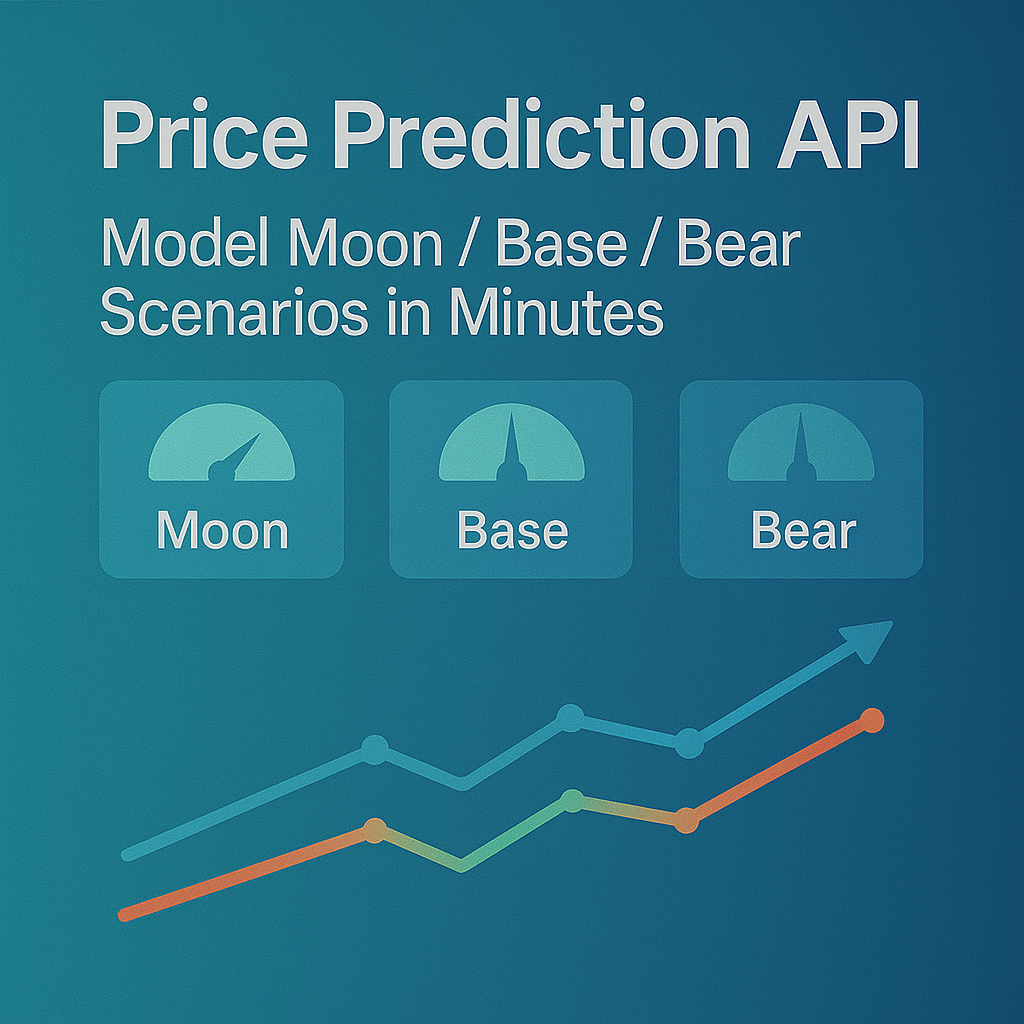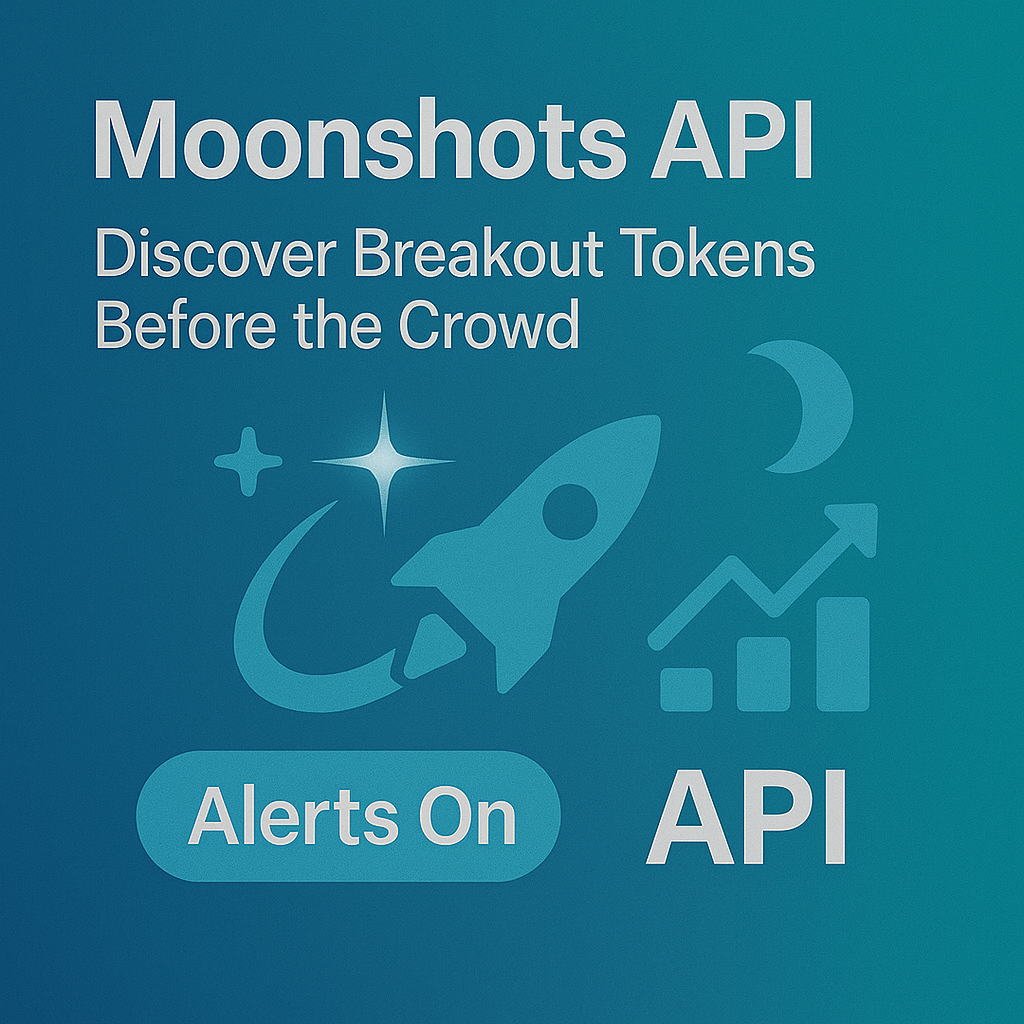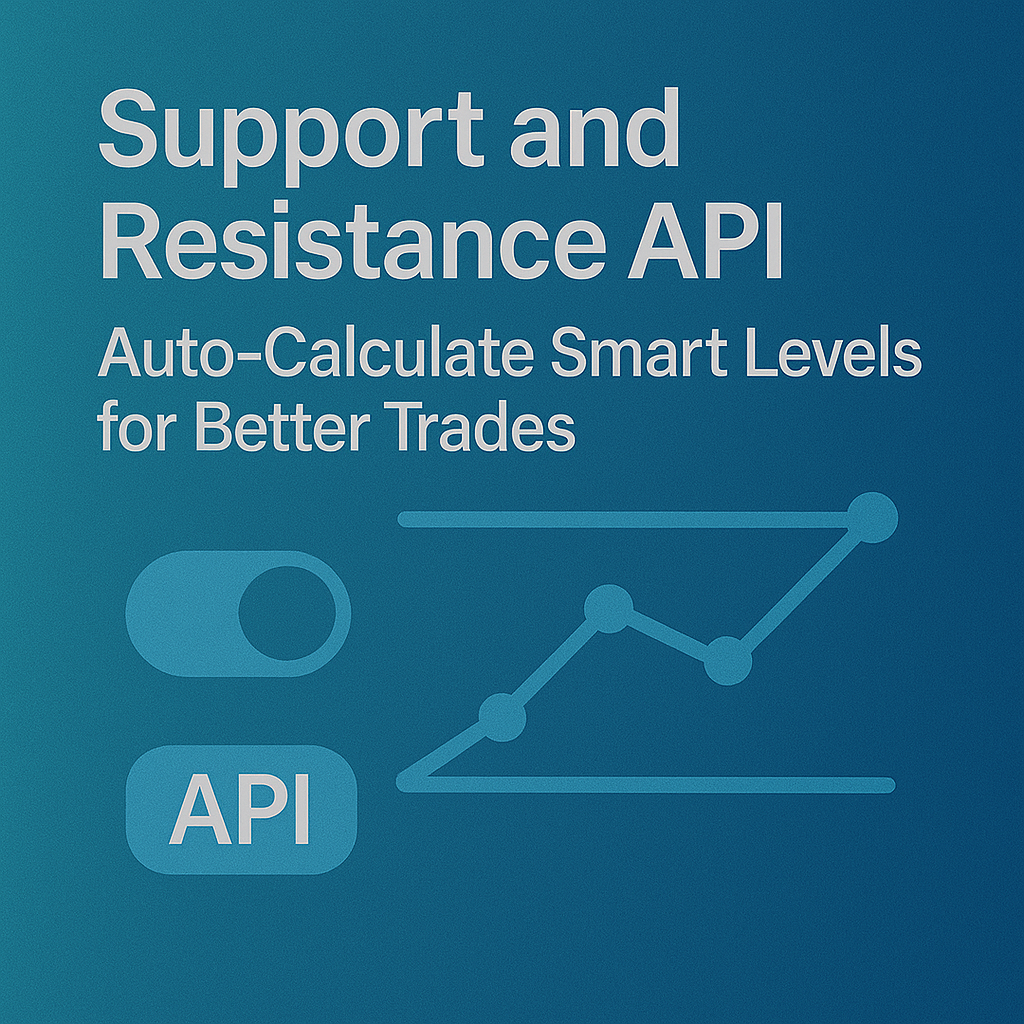Top Crypto Trading Platforms in 2025







%201.svg)
%201.svg)
Big news: We’re cranking up the heat on AI-driven crypto analytics with the launch of the Token Metrics API and our official SDK (Software Development Kit). This isn’t just an upgrade – it's a quantum leap, giving traders, hedge funds, developers, and institutions direct access to cutting-edge market intelligence, trading signals, and predictive analytics.
Crypto markets move fast, and having real-time, AI-powered insights can be the difference between catching the next big trend or getting left behind. Until now, traders and quants have been wrestling with scattered data, delayed reporting, and a lack of truly predictive analytics. Not anymore.
The Token Metrics API delivers 32+ high-performance endpoints packed with powerful AI-driven insights right into your lap, including:
Getting started with the Token Metrics API is simple:
At Token Metrics, we believe data should be decentralized, predictive, and actionable.
The Token Metrics API & SDK bring next-gen AI-powered crypto intelligence to anyone looking to trade smarter, build better, and stay ahead of the curve. With our official SDK, developers can plug these insights into their own trading bots, dashboards, and research tools – no need to reinvent the wheel.
%201.svg)
%201.svg)
The biggest gains in crypto rarely come from the majors. They come from Moonshots—fast-moving tokens with breakout potential. The Moonshots API surfaces these candidates programmatically so you can rank, alert, and act inside your product. In this guide, you’ll call /v2/moonshots, display a high-signal list with TM Grade and Bullish tags, and wire it into bots, dashboards, or screeners in minutes. Start by grabbing your key at Get API Key, then Run Hello-TM and Clone a Template to ship fast.
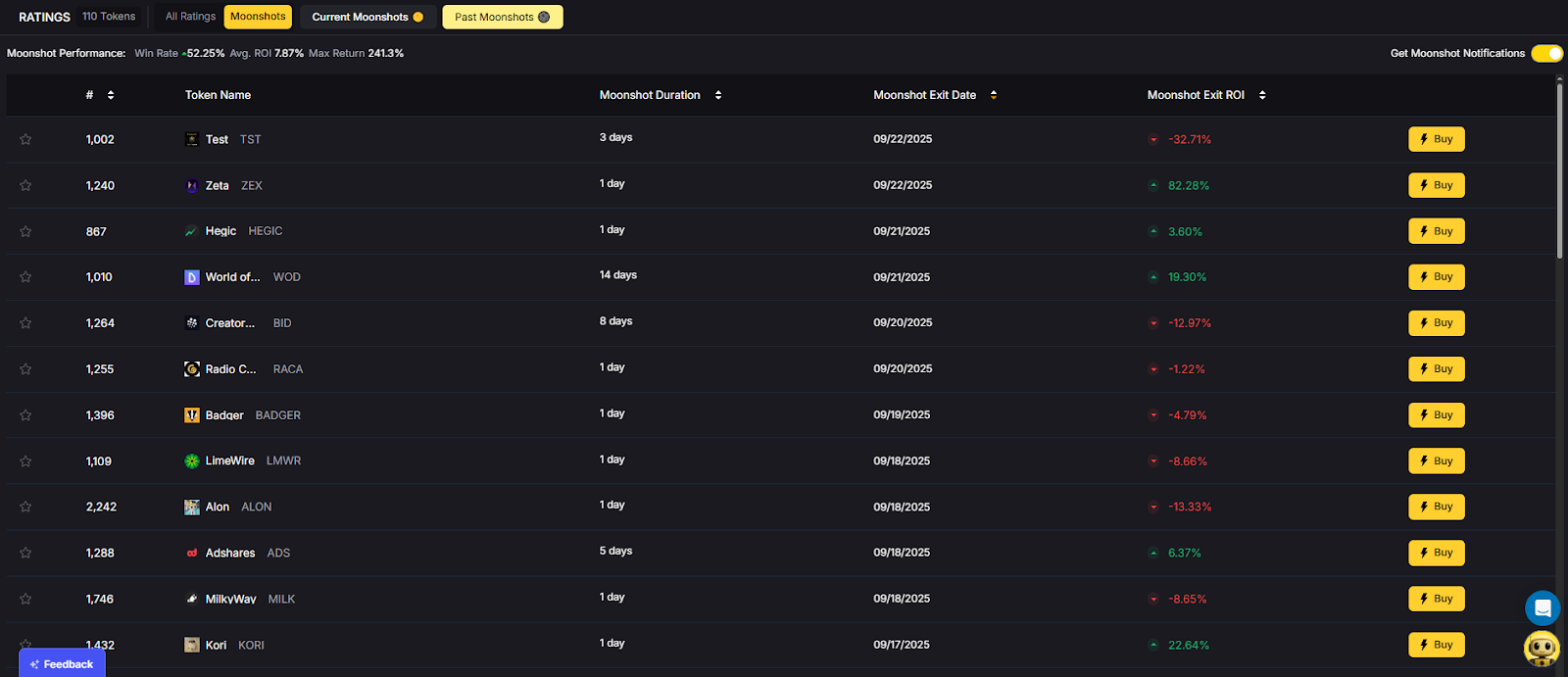
Discovery that converts. Users want more than price tickers—they want a curated, explainable list of high-potential tokens. The moonshots API encapsulates multiple signals into a short list designed for exploration, alerts, and watchlists you can monetize.
Built for builders. The endpoint returns a consistent schema with grade, signal, and context so you can immediately sort, badge, and trigger workflows. With predictable latency and clear filters, you can scale to dashboards, mobile apps, and headless bots without reinventing the discovery pipeline.
The Moonshots API cURL request is right there in the top right of the API Reference. Grab it and start tapping into the potential!
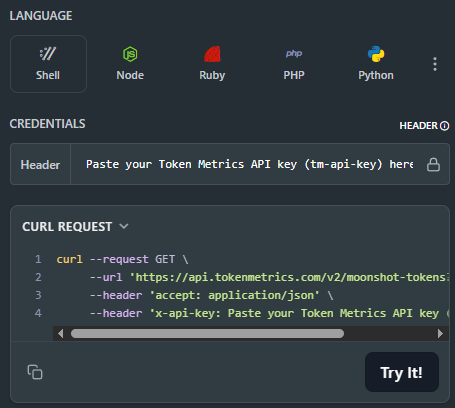
👉 Keep momentum: Get API Key • Run Hello-TM • Clone a Template
Fork a screener or alerting template, plug your key, and deploy. Validate your environment with Hello-TM. When you scale users or need higher limits, compare API plans.
The Moonshots endpoint aggregates a set of evidence—often combining TM Grade, signal state, and momentum/volume context—into a shortlist of breakout candidates. Each row includes a symbol, grade, signal, and timestamp, plus optional reason tags for transparency.
For UX, a common pattern is: headline list → token detail where you render TM Grade (quality), Trading Signals (timing), Support/Resistance (risk placement), Quantmetrics (risk-adjusted performance), and Price Prediction scenarios. This lets users understand why a token was flagged and how to act with risk controls.
Polling vs webhooks. Dashboards typically poll with short-TTL caching. Alerting flows use scheduled jobs or webhooks (where available) to smooth traffic and avoid duplicates. Always make notifications idempotent.
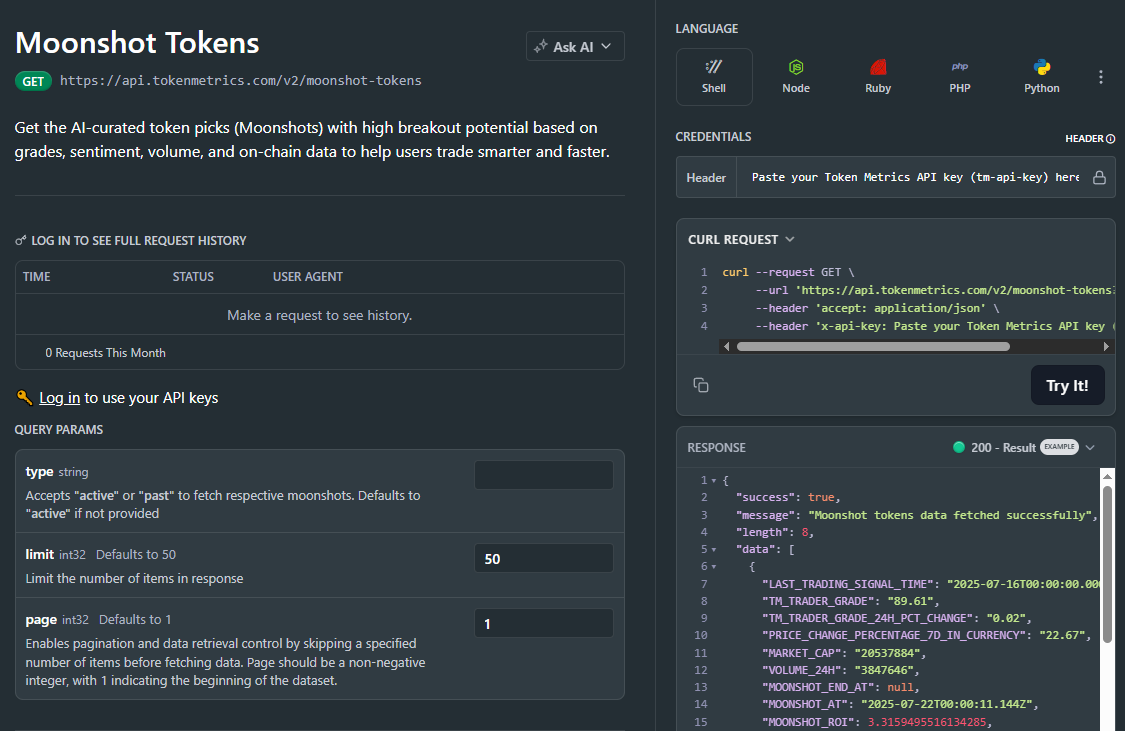
1) What does the Moonshots API return?
A list of breakout candidates with fields such as symbol, tm_grade, signal (often Bullish/Bearish), optional reason tags, and updated_at. Use it to drive discover tabs, alerts, and watchlists.
2) How fresh is the list? What about latency/SLOs?
The endpoint targets predictable latency and timely updates for dashboards and alerts. Use short-TTL caching and queued jobs/webhooks to avoid bursty polling.
3) How do I use Moonshots in a trading workflow?
Common stack: Moonshots for discovery, Trading Signals for timing, Support/Resistance for SL/TP, Quantmetrics for sizing, and Price Prediction for scenario context. Always backtest and paper-trade first.
4) I saw results like “+241%” and a “7.5% average return.” Are these guaranteed?
No. Any historical results are illustrative and not guarantees of future performance. Markets are risky; use risk management and testing.
5) Can I filter the Moonshots list?
Yes—pass parameters like min_grade, signal, and limit (as supported) to tailor to your audience and keep pages fast.
6) Do you provide SDKs or examples?
REST works with JavaScript and Python snippets above. Docs include quickstarts, Postman collections, and templates—start with Run Hello-TM.
7) Pricing, limits, and enterprise SLAs?
Begin free and scale up. See API plans for rate limits and enterprise options.
%201.svg)
%201.svg)
Most traders still draw lines by hand in TradingView. The support and resistance API from Token Metrics auto-calculates clean support and resistance levels from one request, so your dashboard, bot, or alerts can react instantly. In minutes, you’ll call /v2/resistance-support, render actionable levels for any token, and wire them into stops, targets, or notifications. Start by grabbing your key on Get API Key, then Run Hello-TM and Clone a Template to ship a production-ready feature fast.
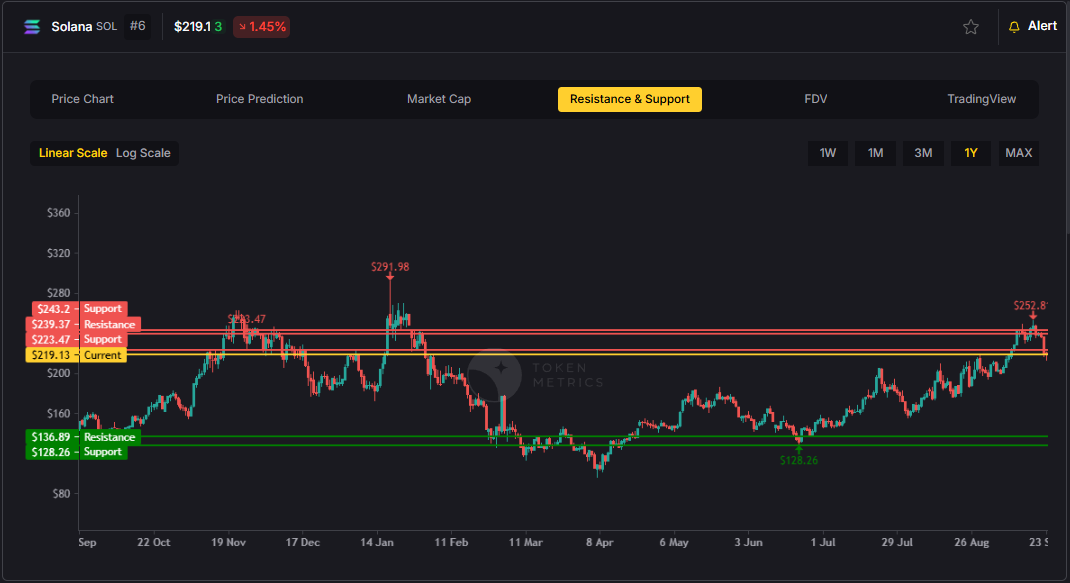
Precision beats guesswork. Hand-drawn lines are subjective and slow. The support and resistance API standardizes levels across assets and timeframes, enabling deterministic stops and take-profits your users (and bots) can trust.
Production-ready by design. A simple REST shape, predictable latency, and clear semantics let you add levels to token pages, automate SL/TP alerts, and build rule-based execution with minimal glue code.
Need the Support and Resistance data? The cURL request for it is in the top right of the API Reference for quick access.
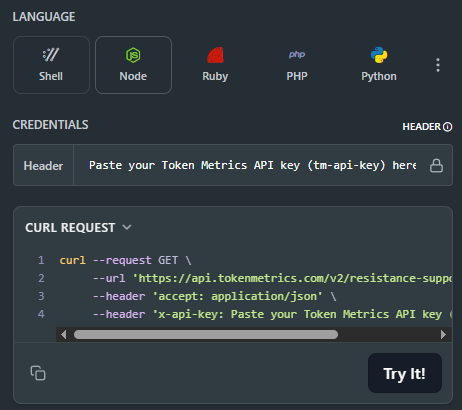
👉 Keep momentum: Get API Key • Run Hello-TM • Clone a Template
Kick off with our quickstarts—fork a bot or dashboard template, plug your key, and deploy. Confirm your environment by Running Hello-TM. When you’re scaling or need webhooks/limits, review API plans.
The Support/Resistance endpoint analyzes recent price structure to produce discrete levels above and below current price, along with strength indicators you can use for priority and styling. Query /v2/resistance-support?symbol=<ASSET>&timeframe=<HORIZON> to receive arrays of level objects and timestamps.
Polling vs webhooks. For dashboards, short-TTL caching and batched fetches keep pages snappy. For bots and alerts, use queued jobs or webhooks (where applicable) to avoid noisy, bursty polling—especially around market opens and major events.
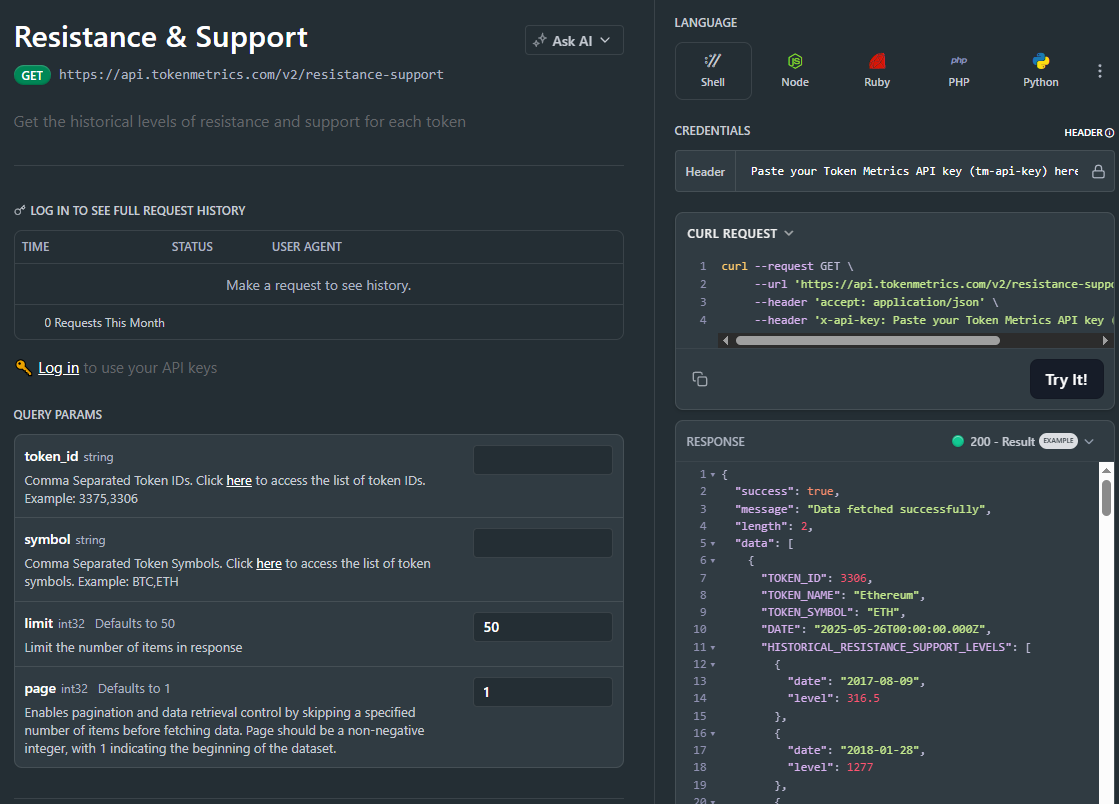
1) What does the Support & Resistance API return?
A JSON payload with arrays of support and resistance levels for a symbol (and optional timeframe), each with a price and strength indicator, plus an update timestamp.
2) How timely are the levels? What are the latency/SLOs?
The endpoint targets predictable latency suitable for dashboards and alerts. Use short-TTL caching for UIs, and queued jobs or webhooks for alerting to smooth traffic.
3) How do I trigger alerts or trades from levels?
Common patterns: alert when price is within X% of a level, touches a level, or breaks beyond with confirmation. Always make downstream actions idempotent and respect rate limits.
4) Can I combine levels with other endpoints?
Yes—pair with /v2/trading-signals for timing, /v2/tm-grade for quality context, and /v2/quantmetrics for risk sizing. This yields a complete decide-plan-execute loop.
5) Which timeframe should I use?
Intraday bots prefer shorter horizons; swing/position dashboards use daily or higher-timeframe levels. Offer a timeframe toggle and cache results per setting.
6) Do you provide SDKs or examples?
Use the REST snippets above (JS/Python). The docs include quickstarts, Postman collections, and templates—start with Run Hello-TM.
7) Pricing, limits, and enterprise SLAs?
Begin free and scale as you grow. See API plans for rate limits and enterprise SLA options.
%201.svg)
%201.svg)
Most traders see price—quants see probabilities. The Quantmetrics API turns raw performance into risk-adjusted stats like Sharpe, Sortino, volatility, drawdown, and CAGR so you can compare tokens objectively and build smarter bots and dashboards. In minutes, you’ll query /v2/quantmetrics, render a clear performance snapshot, and ship a feature that customers trust. Start by grabbing your key at Get API Key, Run Hello-TM to verify your first call, then Clone a Template to go live fast.
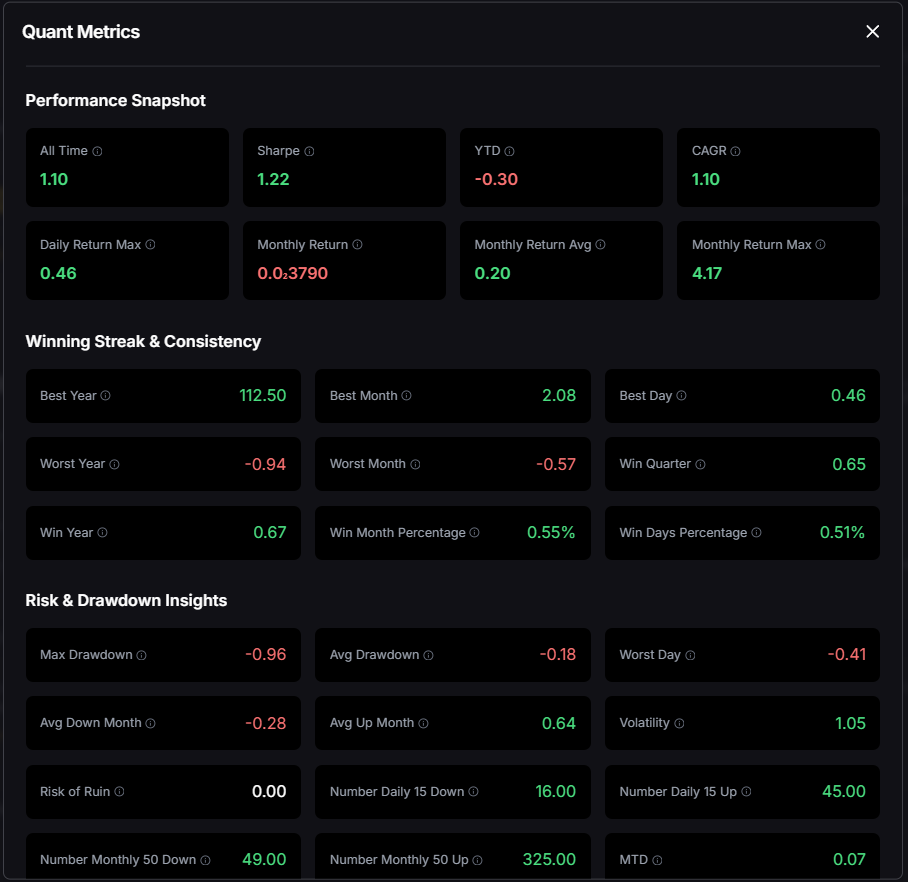
Risk-adjusted truth beats hype. Price alone hides tail risk and whipsaws. Quantmetrics compresses edge, risk, and consistency into metrics that travel across assets and timeframes—so you can rank universes, size positions, and communicate performance like a pro.
Built for dev speed. A clean REST schema, predictable latency, and easy auth mean you can plug Sharpe/Sortino into bots, dashboards, and screeners without maintaining your own analytics pipeline. Pair with caching and batching to serve fast pages at scale.
The Quant Metrics cURL request is located in the top right of the API Reference, allowing you to easily integrate it with your application.
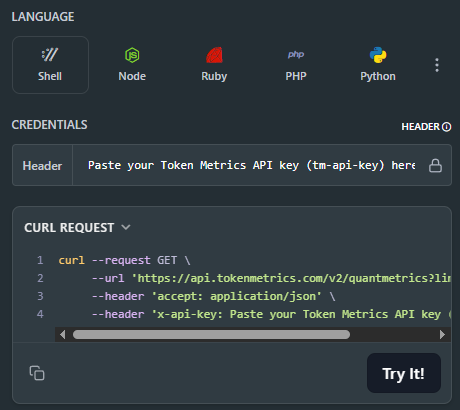
👉 Keep momentum: Get API Key • Run Hello-TM • Clone a Template
Kick off from quickstarts in the docs—fork a dashboard or screener template, plug your key, and deploy in minutes. Validate your environment with Run Hello-TM; when you need more throughput or webhooks, compare API plans.
Quantmetrics computes risk-adjusted performance over a chosen lookback (e.g., 30d, 90d, 1y). You’ll receive a JSON snapshot with core statistics:
Call /v2/quantmetrics?symbol=<ASSET>&window=<LOOKBACK> to fetch the current snapshot. For dashboards spanning many tokens, batch symbols and apply short-TTL caching. If you generate alerts (e.g., “Sharpe crossed 1.5”), run a scheduled job and queue notifications to avoid bursty polling.
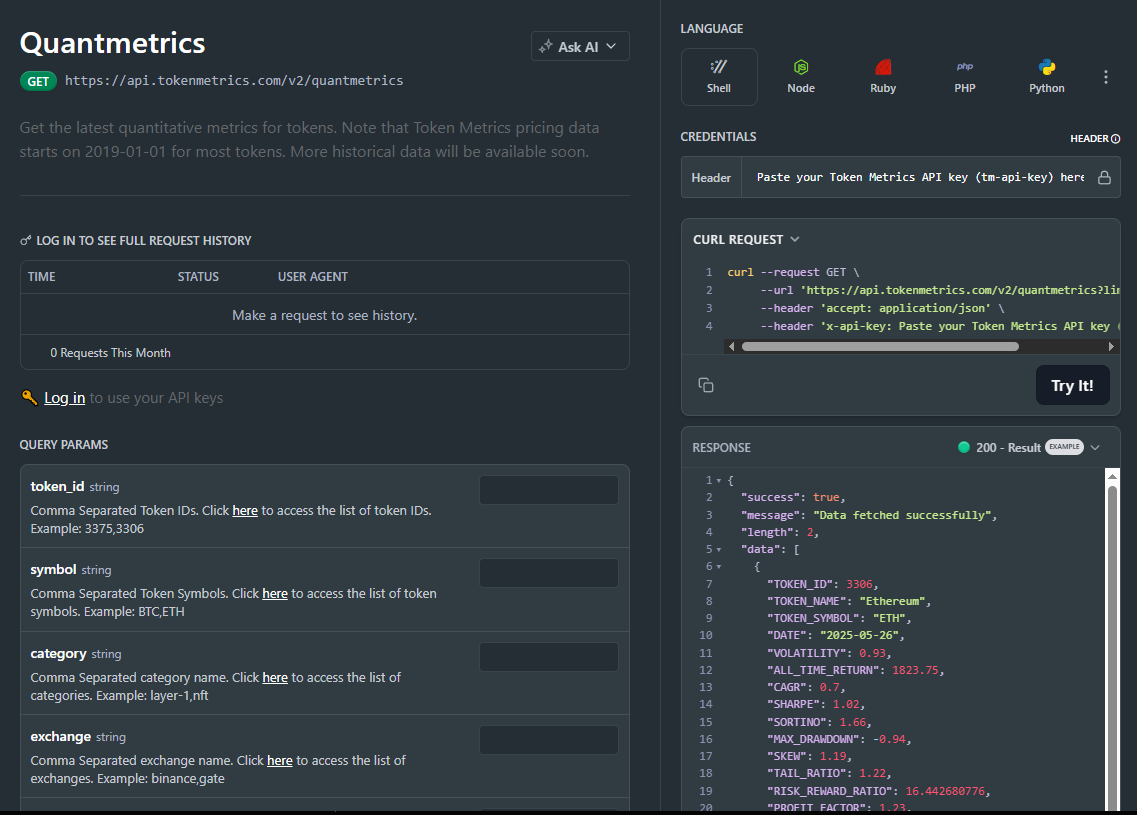
1) What does the Quantmetrics API return?
A JSON snapshot of risk-adjusted metrics (e.g., Sharpe, Sortino, volatility, max drawdown, CAGR) for a symbol and lookback window—ideal for ranking, sizing, and dashboards.
2) How fresh are the stats? What about latency/SLOs?
Responses are engineered for predictable latency. For heavy UI usage, add short-TTL caching and batch requests; for alerts, use scheduled jobs or webhooks where available.
3) Can I use Quantmetrics to size positions in a live bot?
Yes—many quants size inversely to volatility or require Sharpe ≥ X to trade. Always backtest and paper-trade before going live; past results are illustrative, not guarantees.
4) Which lookback window should I choose?
Short windows (30–90d) adapt faster but are noisier; longer windows (6–12m) are steadier but slower to react. Offer users a toggle and cache each window.
5) Do you provide SDKs or examples?
REST is straightforward (JS/Python above). Docs include quickstarts, Postman collections, and templates—start with Run Hello-TM.
6) Polling vs webhooks for quant alerts?
Dashboards usually use cached polling. For threshold alerts (e.g., Sharpe crosses 1.0), run scheduled jobs and queue notifications to keep usage smooth and idempotent.
7) Pricing, limits, and enterprise SLAs?
Begin free and scale up. See API plans for rate limits and enterprise SLA options.

%201.svg)
%201.svg)
Crypto markets are evolving — and fast. In the early days, retail investors dominated the space. But by 2025, the tides are shifting. Institutional investors, family offices, and algorithmic funds are entering the market at scale. This blog explores the growing divide — and how it’s reshaping opportunities for everyday traders.
The Rise of Institutional Money in Crypto
Over the last year, a new class of investors has emerged: professional firms with deep pockets and long-term horizons. They're no longer just “exploring crypto” — they’re actively deploying capital.
Why now?
What Are Institutions Buying?
Institutions tend to avoid meme coins and hyper-volatility. Instead, they focus on:
Token Metrics has seen a spike in institutional users filtering by Investor Grade and project fundamentals.
Retail Traders Still Dominate One Arena
Retail traders are far from out — they dominate high-volatility narratives:
Retail’s edge? Speed, risk tolerance, and virality. Many of Token Metrics’ bold signals still originate from this activity before institutions catch on.
Token Metrics Bridging the Divide
What makes Token Metrics powerful in 2025 is its ability to serve both segments:
This dual capability creates a level playing field, where data, not capital, is the edge.
How to Trade Based on Who’s in Control
Market Behavior Patterns to Watch
Conclusion
The crypto market in 2025 is being driven by both the old guard and the new wave. Institutions bring maturity. Retail brings momentum. Smart investors use tools like Token Metrics to read the room — and position themselves accordingly.

%201.svg)
%201.svg)
Crypto trading success often boils down to timing. But how do you know when to enter — and when to stay long? Token Metrics solves this dilemma with a dual-grade system: Trader Grade and Investor Grade. Each grade serves a different investment goal, and together, they help you make more confident decisions, whether you’re day trading or holding for the long run.
What is the Trader Grade?
The Trader Grade measures short-term momentum. It uses AI to analyze price action, volume trends, technical indicators, and recent sentiment shifts. Scores range from 0 to 100, and a score above 80 signals strong short-term potential.
Use Case:
What is the Investor Grade?
The Investor Grade focuses on long-term fundamentals. It’s designed for those who want to hold tokens for months or even years. This grade considers tokenomics, development activity, ecosystem strength, narrative alignment, and long-term price structure.
Use Case:
Why Use Both?
Most traders fail by only looking at hype or short-term charts. Token Metrics lets you blend data:
Case Study: Balancing Your Portfolio with Grades
Users can use the dual-grade approach for smarter allocation:
This method helps mitigate risk and improve overall ROI.
Where to Find the Grades
Both grades are displayed prominently across:
Tips for Grade-Based Trading
Conclusion
Trading without context is gambling. Token Metrics’ Trader and Investor Grades give you a proven framework for assessing both momentum and fundamentals. Whether you’re here for a quick flip or a long-term bet, using the dual-grade system can level up your crypto strategy.

%201.svg)
%201.svg)
The power of any great API isn’t just in the data it provides — it’s also in the control, visibility, and accountability it gives developers. That’s why the Token Metrics API Dashboard is more than just a place to generate keys — it’s your real-time command center for monitoring API key usage, managing access, and optimizing performance.
In this article, we’ll explore how to use the Token Metrics API Dashboard to stay in control of your app’s data usage, track request history, and ensure your integrations remain secure and efficient.
To access the dashboard:
The API Keys section gives you a complete overview of every active key associated with your account. For each key, you’ll see:
In the Usage Dashboard, Token Metrics gives you deep insights into how your API credits are being used.
This dashboard doesn’t just monitor—it helps you debug and optimize.
If you’re on a Basic or Advanced plan, you’ll have a rate limit (e.g., 1 req/min for free users, up to 600 req/min for VIPs). The dashboard helps ensure you stay within your limits — and scale appropriately when needed.
In a production environment, visibility into API activity is critical. With Token Metrics, you’re never flying blind. You always know:
From security to scaling, the Token Metrics API Dashboard gives you the insight you need to build with clarity and control.

%201.svg)
%201.svg)
The crypto market isn't clearly bullish or bearish in mid-2025 — it's neutral. This article explores why this 'in-between' momentum could signal a maturing market cycle, and what investors should watch for as signals normalize after a sharp $1T rebound in total market cap.
As we navigate through the midpoint of 2025, one question dominates trading desks and Telegram groups alike: Is the crypto market bullish or bearish? Surprisingly, the answer might be neither. Current indicators suggest that we are in a neutral zone — an ambiguous space where the market is no longer surging with euphoric gains but isn’t plunging into panic either.
From January through mid-May, the total crypto market cap has grown from $1 trillion to $2 trillion. This swift rebound signals recovery, but not full-blown optimism. Instead, many analysts — ourselves included — interpret this as a healthy correction and stabilization following intense early-year volatility.
This kind of environment often marks the early stages of a maturing cycle. Unlike the sharp swings we saw in previous bull and bear markets, 2025’s trend suggests more measured growth, driven by fundamentals rather than hype. In other words, the market might finally be learning from its past.
That doesn’t mean the space lacks activity. Sectors like DeFi lending and AI-related tokens continue to gain traction, with significant TVL inflows. Retail interest in meme coins also remains high in select regions. But overall, what we’re seeing is consolidation — not chaos.
In this neutral setting, strategy matters more than sentiment. It's no longer about jumping into trending narratives or panic-selling on dips. Instead, identifying projects with real use cases, sustainable economics, and strong communities has become the foundation of long-term success.
For traders and builders alike, the current landscape offers both challenges and opportunities. Risk-adjusted returns are key, and disciplined portfolio rebalancing could be one of the most underrated strategies right now.
As we continue monitoring market signals, we remain committed to surfacing actionable insights backed by real-time data, not just narratives. Whether the next breakout is weeks or months away, staying informed — and unemotional — may prove to be your best edge.
How Token Metrics Helps in a Neutral Market Environment:
In times of neutral momentum, making profitable crypto decisions becomes more complex — and that's where Token Metrics shines:
In a market where being early beats being emotional, Token Metrics equips you with the clarity and tools to trade with confidence.

%201.svg)
%201.svg)
We’re thrilled to announce one of our most important product launches to date: the Token Metrics API is now live.
This powerful crypto API gives developers, quant traders, and crypto startups direct access to the core AI infrastructure that powers the Token Metrics platform. Whether you’re building trading agents, investor dashboards, research tools, or mobile apps, our API and SDKs provide everything you need to build with real-time crypto data and intelligence—right out of the box.
For the first time, you can plug into the same AI API that drives our ratings, signals, and predictions—and embed it directly into your products, tools, or internal systems.
Our crypto API is designed to give you high-performance access to the exact data models we use in-house:
Access bullish and bearish calls across thousands of tokens. These API endpoints are powered by machine learning models trained on historical price action, sentiment data, and blockchain activity.
Through our API, you can pull dynamic 0–100 grades on any token. Designed for long-term or short-term views, these scores factor in volatility, momentum, market cap trends, and our proprietary AI predictions.
Query the API to generate custom reports and insights using our smart crypto assistant. Analyze market trends, token health, and investment opportunities—without writing your own models.
Retrieve token-level analytics like ROI, predictive volatility, and asset rankings. Perfect for powering dashboards, investor tools, or internal models.
Use the API to access our AI-modeled sentiment engine, built from social media, news data, and trend signals—ideal for gauging crowd psychology.
All Token Metrics API endpoints are RESTful, fast, and easy to integrate. SDKs for Python, Node.js, and other environments help developers onboard quickly.
Our users are already building next-gen tools and automation using the Token Metrics API:
With just a few lines of code and an API key, you can turn static crypto apps into dynamic, intelligent systems.
We’ve designed our crypto API pricing to be flexible and accessible:
Whether you're a solo dev or scaling a trading startup, there’s a plan built for you. Paying with $TMAI also deepens your utility in the Token Metrics ecosystem—this is just the beginning of native token perks.
Not ready to commit? Try our free API tier with:
Start exploring at tokenmetrics.com/api
Token Metrics has always been focused on empowering smarter investing. But as the market evolves, we believe the future lies in infrastructure, automation, and open access.
That’s why we built the Token Metrics API—to give developers access to the exact AI systems we use ourselves. Our models have been fine-tuned over years, and now, that same intelligence can power your platform, tools, or trading agents.
Whether you're building research platforms, signal-based apps, or automated execution tools—this API is your edge.
The crypto market never sleeps—and with the Token Metrics API, neither do your tools.

%201.svg)
%201.svg)
Introduction
With thousands of crypto tokens flooding the market, finding the best-performing assets can feel like searching for a needle in a haystack. Token Metrics is solving this with a revamped Market Page experience — designed to surface top signals faster and help users make smarter trading decisions.
Why the Market Page Matters
The Market Page is the heartbeat of Token Metrics' analytics platform. It showcases real-time data on the latest bullish and bearish signals across tokens, providing users with instant access to the platform’s top-rated opportunities. With the recent update, it’s now more powerful and user-friendly than ever.
What’s New in the Market Page?
How It Helps Traders
This upgrade isn't just cosmetic. It fundamentally changes how traders interact with the platform:
Case Study: Launch Coin
Launch Coin, the best performing token in 2025 with a 35x return, was identified early thanks to the Market Page’s bold signal tracking. Its signal rose to the top immediately after performance started climbing — helping early users lock in life-changing gains.
How to Use the Market Page Like a Pro
The Power of Daily Signals
With market conditions changing fast, the daily updates on the Market Page give Token Metrics users an edge — surfacing fresh opportunities before they trend on social media or make headlines.
Conclusion
The new Market Page isn’t just a dashboard — it’s a discovery engine. Designed for both beginner and experienced traders, it brings clarity, speed, and precision to crypto investing.

%201.svg)
%201.svg)
Introduction
In the ever-evolving world of crypto, understanding the cyclical relationship between Bitcoin and altcoins is crucial for successful trading. During Token Metrics’ latest market update, Ian Balina highlighted key indicators pointing to a shift in momentum — possibly signaling the return of an altcoin season.
What Is Altcoin Season?
Altcoin season is a period in the crypto market where altcoins outperform Bitcoin in terms of price gains. Historically, this shift occurs when Bitcoin stabilizes after a rally, giving room for capital rotation into smaller-cap tokens with higher risk/reward potential.
Bitcoin’s Dominance and the Signs of Rotation
As of May 2025, Bitcoin remains a market anchor, but its dominance is showing signs of plateauing. Ian pointed out that capital is beginning to flow into AI tokens, new infrastructure plays, and community-driven projects like Launchcoin — which has already returned 35x gains. These trends are classic precursors to altcoin season.
Top Performing Altcoins Identified by Token Metrics
Token Metrics’ bold signals have identified several high-performing altcoins, such as:
Key Indicators to Watch
How to Prepare Your Portfolio
Traders should consider gradual rotation — locking in BTC gains and reallocating to top-rated altcoins. Using Token Metrics’ tools:
Conclusion
Whether we’re entering a full-blown altcoin season or just a mini-cycle, the signals are clear: capital is rotating. Use data, not guesswork. With Token Metrics’ AI-powered tools, you can identify high-potential opportunities and stay ahead of the curve in both Bitcoin and altcoin markets.

%201.svg)
%201.svg)
Introduction
AI is no longer just a tech buzzword — it’s a dominant force driving the next wave of crypto innovation. In 2025, artificial intelligence has found a new frontier: blockchain. From infrastructure protocols to AI-native tokens, the market is seeing a surge in interest, investment, and returns for coins tied to the AI narrative. Token Metrics is at the forefront, helping users identify these explosive opportunities.
Why AI Coins Are Surging
The intersection of AI and crypto isn’t random. Three forces are converging to power this narrative:
Token Metrics’ AI Token Detection Strategy
Token Metrics uses its proprietary AI to identify early momentum in the market. Here's how it helped surface the best-performing AI tokens:
Ian Balina noted during the recent webinar that several AI coins have already delivered outsized returns — and this is just the beginning.
Examples of AI Tokens to Watch
How to Ride the AI Wave
Using the Token Metrics platform, here’s how to position your portfolio:
What This Means for Investors
The AI narrative is not a flash in the pan. It represents a paradigm shift in both technology and finance. Tokens that combine utility, vision, and timing will thrive. As always, early entry is key — and that’s where Token Metrics’ daily insights give users the edge.
Conclusion
AI tokens are fueling the next crypto bull run — and the smartest investors are already positioned. With real-time signals, narrative filters, and AI-powered grading, Token Metrics is your map through the chaos. The next big opportunity may already be on the Market Page.

%201.svg)
%201.svg)
The crypto world thrives on narratives, and few have captured attention in recent weeks like Launchcoin. Born from a blend of SocialFi innovation and meme-driven virality, Launchcoin has surged into the spotlight—offering both eye-popping returns and warnings of extreme volatility. Powered by Token Metrics’ AI insights, here’s a detailed look at where Launchcoin stands today.
On April 20, 2025, Token Metrics’ proprietary AI model flipped bullish on Launchcoin. Since then, the token has rallied over 3x, proving the strength of the signal. Backed by machine learning models that track on-chain data, sentiment, and price action across multiple timeframes, the Trader Grade for Launchcoin is currently at a whopping 93.15%, designating it a Strong Buy in the short term.
However, after such an exponential surge, the platform’s analysts expect natural pullbacks as early buyers and whales begin to take profits. These corrections are healthy and expected in any meteoric price run—and should not be confused with a loss of fundamental strength.
While short-term indicators are overwhelmingly bullish, the Investor Grade remains neutral, pointing to a more measured view on Launchcoin’s long-term potential. This signals that while there’s momentum, there are still structural risks—particularly due to its meme coin characteristics and reliance on hype cycles.
Still, a neutral long-term grade isn’t bearish. It suggests Launchcoin is currently stable at its elevated valuation, but investors should monitor developments carefully—especially as new features and ecosystem growth unfold.
The Launchcoin story has already minted millionaires. One trader reportedly turned an $8,191 investment (54 SOL) into $4 million after purchasing 14.62 million LAUNCHCOIN tokens when the market cap was below $500,000. This kind of exponential return is rare—even in crypto—and helped drive speculative interest across social media and trading forums.
Within just 22 days, Launchcoin’s market cap crossed $300 million, illustrating how quickly meme-based projects can capture market momentum, especially when they ride the wave of a compelling narrative.
Launchcoin’s liquidity and accessibility have improved significantly. The token is now trading on major centralized exchanges:
These listings have broadened exposure, attracting a wider investor base and allowing leveraged traders to participate. Increased liquidity also reduces slippage, enabling larger capital inflows while minimizing execution risk.
Initially launched as PASTERNAK, named after Believe’s founder Ben Pasternak, the project was rebranded to Launchcoin on May 2, 2025. The new name better reflects its core value proposition: empowering creators to launch tokens through a SocialFi model.
The model is simple but revolutionary—anyone can create a token by posting on social media with the “@launchcoin” tag. This lowers the barrier for entry into token creation and adds viral potential to every social interaction.
Despite its recent success, Launchcoin remains a highly speculative asset. Its meteoric rise is reminiscent of meme coin cycles seen with tokens like PEPE or DOGE. While Launchcoin offers a unique utility layer with its token-creation feature, its current valuation includes a significant hype premium.
Token Metrics encourages traders to stay nimble. With the AI trading signals, users can track grade changes in real-time, ensuring they’re not caught off guard by sharp reversals or cooldowns.
Launchcoin represents a blend of viral marketing, social token innovation, and AI-predicted trading opportunity. With strong short-term momentum, neutral long-term positioning, and significant ecosystem buzz, it’s a token to watch—but not without caution.
Whether you’re a trader riding the momentum or an investor assessing long-term viability, Token Metrics provides the data-driven edge to navigate Launchcoin’s volatility with confidence.


 Create Your Free Account
Create Your Free Account9450 SW Gemini Dr
PMB 59348
Beaverton, Oregon 97008-7105 US
.svg)




.png)
Token Metrics Media LLC is a regular publication of information, analysis, and commentary focused especially on blockchain technology and business, cryptocurrency, blockchain-based tokens, market trends, and trading strategies.
Token Metrics Media LLC does not provide individually tailored investment advice and does not take a subscriber’s or anyone’s personal circumstances into consideration when discussing investments; nor is Token Metrics Advisers LLC registered as an investment adviser or broker-dealer in any jurisdiction.
Information contained herein is not an offer or solicitation to buy, hold, or sell any security. The Token Metrics team has advised and invested in many blockchain companies. A complete list of their advisory roles and current holdings can be viewed here: https://tokenmetrics.com/disclosures.html/
Token Metrics Media LLC relies on information from various sources believed to be reliable, including clients and third parties, but cannot guarantee the accuracy and completeness of that information. Additionally, Token Metrics Media LLC does not provide tax advice, and investors are encouraged to consult with their personal tax advisors.
All investing involves risk, including the possible loss of money you invest, and past performance does not guarantee future performance. Ratings and price predictions are provided for informational and illustrative purposes, and may not reflect actual future performance.

